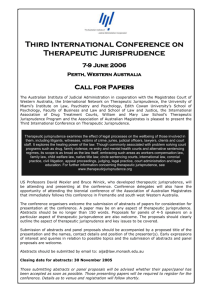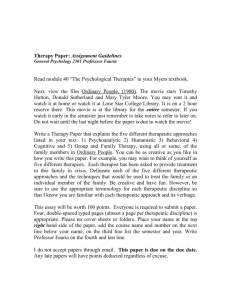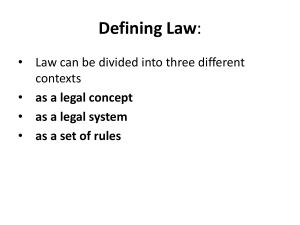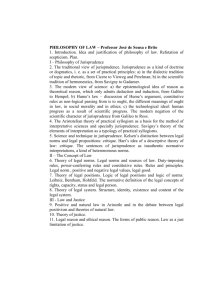Keroack
advertisement
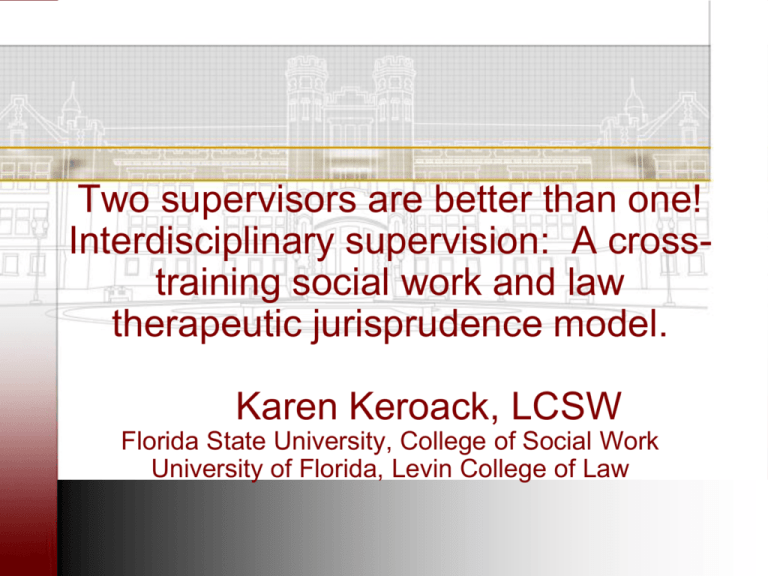
Two supervisors are better than one! Interdisciplinary supervision: A crosstraining social work and law therapeutic jurisprudence model. Karen Keroack, LCSW Florida State University, College of Social Work University of Florida, Levin College of Law Unifying philosophy for social workers and lawyers Therapeutic jurisprudence (TJ) defined: It examines the therapeutic and antitherapeutic consequences that flow from legal rules, legal procedures, and the behaviors of legal actors. (Stolle & Wexler, 1997, found in Madden & Wayne, 2003) “TJ” Basic proposition: The law should promote therapeutic outcomes for the individuals, families, and communities affected by it. Provides a common orientation to legal situations An innovative approach to examine legal issues from a systems perspective Supports collaborative interdisciplinary practice and creates a venue for individuals to engage in dialogue and creative problem solving Our legal advocacy clinic Who do we serve? Why are more heads better than one? Who are the team members and what does each professional team member bring? What is our model of representation? Nuts and bolts about how it works! The practical side Informal and formal processes: – referrals, case selection, case assignments, firm meetings, team meetings, case management and documentation, interdisciplinary supervision, teaching Cross-professional training Differences and similarities – Ethical considerations – Boundaries and role definition – Language – Professional courtesy and respect – Values Synergistic effects of cross training Interdisciplinary supervision Two supervisors are better than one! – Legal and social work perspective encourages holistic representation – Legal and social work constructs are used to build knowledge build knowledge, inform practice decisions, increase self-awareness, promote relationship building skills and professionalism Supervisory functions and roles Supervisor as Teacher – Structures experience and clarifies expectations, understands and supports supervisee as learner, links theory with practice, modes, identifies and explains appropriate engagement, assessment, intervention and evaluation strategies, provides feedback and evaluates performance Supervisor as Counselor – Explores feelings and concerns, facilitates self-exploration and selfawareness, provides opportunities to process and define supervisees strengths and areas of development Supervisor as Consultant – Allows supervisee to structure the supervision, acts as a resource but encourages the supervisee to trust his/her own thoughts, insights and feelings about the work with the client, supports collaboration Social Work Constructs Ecological systems perspective Relationship building skills – Developing rapport, use of self, active listening, empathic communication, selfdisclosure, authenticity, boundaries, strengths perspective, reframing, partialization, transference, readiness for change, empowerment Social Work Constructs Ethical principles – Commitment to clients, self-determination, informed consent, cultural competence, awareness of conflicts of interest, privacy and confidentiality Four stages of planned change – Engagement, assessment, intervention, and evaluation Social Work Constructs Micro-level analysis Macro-level analysis References Brooks, S. (2005). Practicing (and teaching) therapeutic jurisprudence: Importing social work principles and techniques into clinical legal education. St Thomas Law Review, 17, 513-530. Brooks, S. (2006). Using therapeutic jurisprudence to build effective relationships with students, clients and communities. Clinical Law Review, 13, 213-230. Hartley, C., Petricci, C. (2004). Practicing culturally competent therapeutic jurisprudence: A collaboration between social work and law. Journal of Law and Policy, 14, 133-181. Kahn, B., O’Donnell, P., Wernsman, J., Bushell, B., Kavanaugh, A. (2007). Making the connection: Legal advocacy and mental health services. Family Court Review, 45(3) 486-500. Galowitz, P. (1999). Collaboration between lawyers and social workers: Re-examining the nature and potential of the relationship. Fordham Law Review, 2123-2154. Hepwoth, D., Rooney, R., Rooney, G., Strom-Gottfried, K., Larsen, J. (2009). Direct social work practice: Theory and skills (8th ed.). California: Brooks/Cole. Madden, R., Wayne, R. (2003). Social work and the law: A therapeutic jurisprudence perspective. Social Work, 48(3), 338-347. Shulman, L., Safyer, A. (2006). Supervision in counseling: Interdisciplinary issues and research. Psychology Press. Silver, M. (2007) The affective assistance of counsel: Practicing law as a healing profession. NC:Carolina Academic Press. Steinberg, R. (2006). Beyond lawyering: How holistic representation makes for good policy, better lawyers, and more satisfied clients. N.Y. Review of Law & Social Change, 30, 625-635. Wright, J. (2005). Therapeutic jurisprudence in an interprofessional practice at the University of St, Thomas Interprofessional Center for Counseling and Legal Services. St. Thomas Law Review, 17, 501-512.

